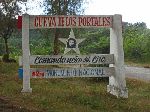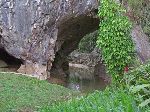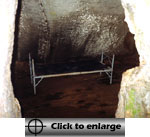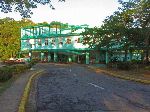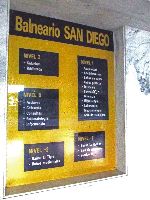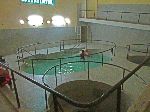| . | ||
Pinar
del Rio
|
||
San Diego de los Banos |
||
| Note from 1998 program: The day started with a rain squall. The first unseasonable weather in a week. Mostly the weather hasn’t been of note and worth a lot of discussion. It has been pleasant and great: enough sun so that we need a sunscreen-applying rituals but also enough overcast to keep the heat down, and the winds were moderate. In the same time period as this trip, in California, Texas and Peru there was flooding, deadly tornadoes in Florida and blistering heat in Latin America. This extreme weather was attributed to the El Niño weather phenomenon. This all prompts the Cubans to tell a joke referencing El Niño – it is also a commentary on their economy. (You also need to know that in Spanish El Niño is the name for the weather phenomenon and "the baby.") "El Niño doesn’t come to Cuba because there is no milk." | ||
|
||
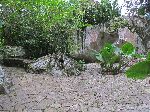 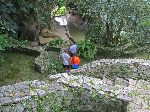 Outside
the cave, the senior staff was guarded by several hundred troops. Inside the
cave, there was a communication room, map room, and Che quarters, which
included a simple disk and chairs, a telephone, and in a deeper cave, his bed.
Outside his office is a bench at which he played checkers, and a couple of trees
between which he lounged in a hammock. Outside
the cave, the senior staff was guarded by several hundred troops. Inside the
cave, there was a communication room, map room, and Che quarters, which
included a simple disk and chairs, a telephone, and in a deeper cave, his bed.
Outside his office is a bench at which he played checkers, and a couple of trees
between which he lounged in a hammock.
|
||
|
After the departure of Che it reverted to its recreational purpose, in the form of historical tourism, referencing the events of October 1962. Unfortunately, there is nothing at Cueva de los Portales to give the large picture of other players in the event, the brinkmanship between the USA and the USSR, and the other important locations in the face-off. |
||
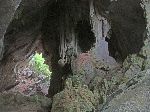
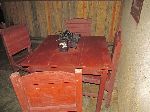
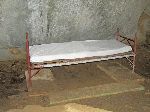
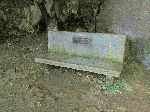
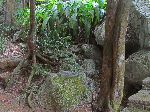 |
||
The tour now sounds like this:
It is interesting to notice how Che's bed augmented or enhanced between 1998 (right) and 2016 (above).. |
||
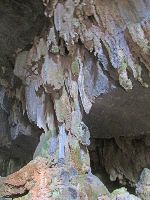 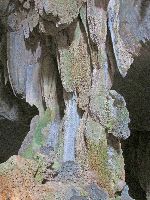 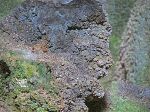 The
cave still has some large formations, but compared to other subterranean
offering in Cuba, this is not the best destination for viewing stalagmites,
stalactites and columns. The
cave still has some large formations, but compared to other subterranean
offering in Cuba, this is not the best destination for viewing stalagmites,
stalactites and columns.One of the Limestone formation at Cueva de los Portales is said to resemble Che (right). |
||
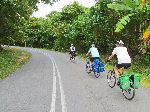 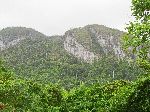 Biosphere Reserve of Sierra del Rosario is the oldest in Cuba and was
declared a UNESCO Biosphere Reserve in 1985. It covers about 27,000 hectares
of mountainous forests, drained by several picturesque rivers. Biosphere Reserve of Sierra del Rosario is the oldest in Cuba and was
declared a UNESCO Biosphere Reserve in 1985. It covers about 27,000 hectares
of mountainous forests, drained by several picturesque rivers.You can’t get much better back roads bicycling. Winding roads through green hills. Occasional climbs with great views to rewards the efforts and then long descents as like extra whip cream on a hot fudge sundae (the sundae was not included). The points of interest along the way each had their own unique touch: |
||
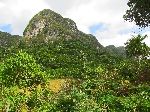 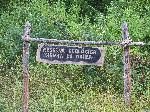 La Guira luxury hotel and forest: Set in
the Reserva Ecologica Sierra la Guira, also hosts la Guira luxury hotel,
which has all of the four star amenities to make one
feel like they were on vacation. La Guira luxury hotel and forest: Set in
the Reserva Ecologica Sierra la Guira, also hosts la Guira luxury hotel,
which has all of the four star amenities to make one
feel like they were on vacation. |
||
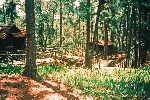 Cabana de los Pinos: Guest cabins suspended in the pines,
built on stilts with wooden catwalks in between for access. Currently they are under
renovation, but they should be ready for tourist again in a couple of years. Cabana de los Pinos: Guest cabins suspended in the pines,
built on stilts with wooden catwalks in between for access. Currently they are under
renovation, but they should be ready for tourist again in a couple of years. |
||
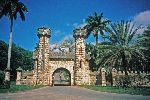 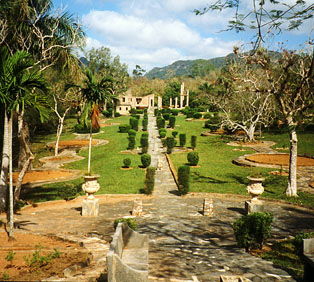 Haciendas Cortina:
This is one of the homes and estates of an extraordinarily wealth José Manuel Cortina y
García (journalist, lawyer, politician, diplomat (in Asia)).
Clearly
the Cortinas had been wealthy. At one time, the
Cortina's controlled the land of a significant part of eastern Pinar del Rio Province (Parque
Nacional La Güira). Haciendas Cortina:
This is one of the homes and estates of an extraordinarily wealth José Manuel Cortina y
García (journalist, lawyer, politician, diplomat (in Asia)).
Clearly
the Cortinas had been wealthy. At one time, the
Cortina's controlled the land of a significant part of eastern Pinar del Rio Province (Parque
Nacional La Güira). |
||
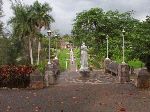
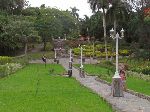
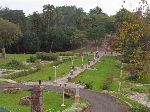
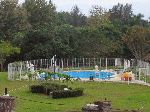
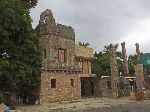
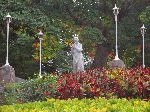 Some
of the buildings and formal gardens still remain.
There is an impressive gate and acres of formal gardens, fountains, pools with
statures, and the stone work of what once was a large multi-story residence. It
had been torched some years ago – maybe 30. After the revolution, the
hacienda was confiscated by the state. The former residential grounds are being
restored and developed as a passive public recreation area. Some
of the buildings and formal gardens still remain.
There is an impressive gate and acres of formal gardens, fountains, pools with
statures, and the stone work of what once was a large multi-story residence. It
had been torched some years ago – maybe 30. After the revolution, the
hacienda was confiscated by the state. The former residential grounds are being
restored and developed as a passive public recreation area. |
||
|
|
||
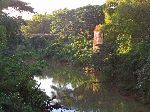 The main feature is a mild sulphur
health spa. It curative properties were purported discovered by a slave, with a
skin disease, who was put out so he would not infect anyone else. He went
swimming at the side of the river and his skin cleared up. The warm water is supposed to be especially good
for curing skin ailments. The spa is not frequented by tourists, but is a
working medical center, and is prescribed as treatment for some conditions by
Cuban doctors. There is a full medical staff at the facility. The pools are used
as physical therapy pools. The main feature is a mild sulphur
health spa. It curative properties were purported discovered by a slave, with a
skin disease, who was put out so he would not infect anyone else. He went
swimming at the side of the river and his skin cleared up. The warm water is supposed to be especially good
for curing skin ailments. The spa is not frequented by tourists, but is a
working medical center, and is prescribed as treatment for some conditions by
Cuban doctors. There is a full medical staff at the facility. The pools are used
as physical therapy pools. |
||
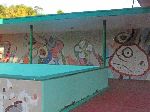
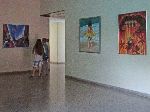
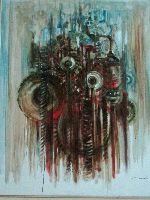  Even
if you don't have a medical reason to visit the spa, it is worth a visit to look
at the art work. There are more than a dozen large, high quality, paintings in the lobby, and a
large wall mural on the plaza. The painting ranged from impressionist, to
realism, to the fanciful and the macabre. Everyone was worth a look. Even
if you don't have a medical reason to visit the spa, it is worth a visit to look
at the art work. There are more than a dozen large, high quality, paintings in the lobby, and a
large wall mural on the plaza. The painting ranged from impressionist, to
realism, to the fanciful and the macabre. Everyone was worth a look. |
||
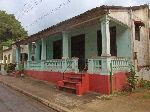
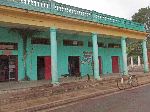
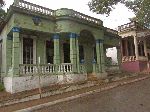
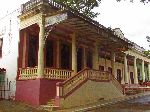
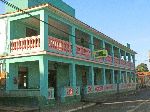 |
||
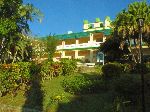 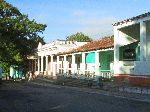 In
the core of San Diego de los Banos, there are a few heritage building that
give it some character. Most are, or were previously, retail space. A couple
are hotels, but they are peso-hotels, so they only serve Cuban Nationals. In
the core of San Diego de los Banos, there are a few heritage building that
give it some character. Most are, or were previously, retail space. A couple
are hotels, but they are peso-hotels, so they only serve Cuban Nationals.A couple blocks away, and slightly up the hill, is a newer, larger hotel to serve international travelers. |
||
| Note from 1998 program: Dinner raised another issue of Cuban economic system. Cubans get ration card for bread (a bun a day), eggs (less than one a day), meat (occasional) oil and a number of other basics. Here we are a bunch of foreigner, without ration cards, and the food was always on the table in greater quantities than would be allowed by the ration cards. Dinner tonight was an exceptional feast! | ||
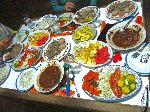 By
2016, in under two-decades, the food situation had changed dramatically: The
available quantity, variety and quality of the food is now astonishing by
comparison. While there is still a gap between what tourists are severed and
what might be on the average Cuban's table, most noticeably access to beef,
their options are also vastly improved, as well. Over time, the offerings in
the ration book have been pared back, and there are rumors that it might be
discontinued all together. By
2016, in under two-decades, the food situation had changed dramatically: The
available quantity, variety and quality of the food is now astonishing by
comparison. While there is still a gap between what tourists are severed and
what might be on the average Cuban's table, most noticeably access to beef,
their options are also vastly improved, as well. Over time, the offerings in
the ration book have been pared back, and there are rumors that it might be
discontinued all together. |
||
|
|
||
    |
||
|
"Hosted by
DreamHost - earth friendly web hosting"
|
||
|
|
|
